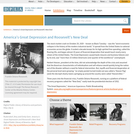
The stock market crash on October 29, 1929 -- known as Black Tuesday -- was the "worst economic collapse in the history of the modern industrial world." It spread from the United States to national economies across the globe. It ended a decade known for its high-spirited free-spending, called the Roaring 20s, and began almost 10 years of financial desperation that would touch nearly every citizen of the United States. The Great Depression caused bank closures and business failures and by its end, saw "more than 15 million Americans (one-quarter of the workforce)" unemployed. Herbert Hoover, president at the time, did not acknowledge the depth of the crisis and assumed that the American characteristics of individualism and self reliance would quickly bring the nation out of the disaster without a need for federal intervention. But, layoffs and financial desperation at the personal level were growing: "an empty pocket turned inside out was called a 'Hoover flag' [and] the decrepit shanty towns springing up around the country were called 'Hoovervilles'." Three years into the financial crisis, Franklin Delano Roosevelt, running on a platform of federal recovery programs called the "New Deal," easily took the presidential election of 1932.
- Subject:
- History
- U.S. History
- Material Type:
- Diagram/Illustration
- Primary Source
- Unit of Study
- Provider:
- Digital Public Library of America
- Provider Set:
- DPLA Exhibitions
- Author:
- Amy Rudersdorf
- Emily Gore
- Date Added:
- 04/01/2013